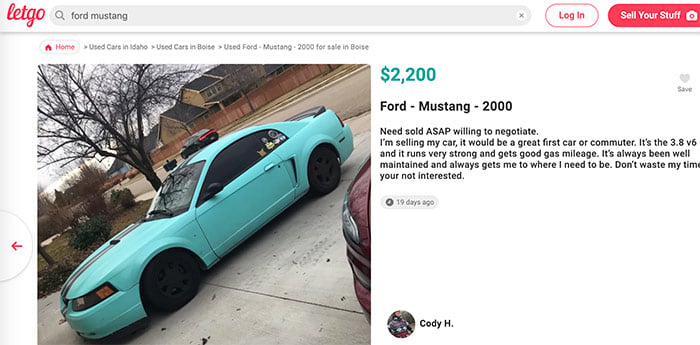
Letgo is an online marketplace that facilitates transactions between consumers. It’s available as a mobile app or a website.
Cody H. is selling a 2000 Ford Mustang with 140,000 miles on Letgo, a mobile peer-to-peer classified app. The asking price is $2,200, but he’s willing to negotiate for a fast sale. Cody and his potential customers are participating in a popular ecommerce business model: consumer-to-consumer.
C2C ecommerce can and does look an awful lot like regular business-to-consumer ecommerce or even B2C sales generally. Here is an example.
Giovanni, my son, found Cody’s listing shortly after 10 a.m. on a Wednesday. Gio is off of work on Wednesdays and, like many of his friends, he is more comfortable shopping for a used car on an app like Letgo than he is scouring a printed classified or visiting a used car dealer. Five months ago, he bought a 1999 Sebring on Letgo for $600.
He plans to buy something a little nicer and then list the Sebring on Letgo and try to get as much of his investment back as possible.
Giovanni could have had a business-to-consumer transaction, not a C2C. Instead of using Letgo, Gio could have gone to a used car dealer. He would have test driven a car, and, perhaps, even traded his Sebring in for something a little nicer.
C2C is unique in that each party is a “consumer” and, in another transaction, their roles might be reversed.
In this article, I will briefly explain six ecommerce business models, including B2C and C2C.
Business-to-consumer
When you think of ecommerce, you probably think of the B2C business model. It is simply retail sales made from a business entity to an individual. Much of Amazon.com uses this model. Nearly every entrepreneur using BigCommerce, Shopify, or a similar hosted ecommerce platform is also likely to be focused on B2C ecommerce.
Within the B2C ecommerce model, there are subcategories, if you will. As an example, you could have a B2C subscription business such as Stitch Fix, Dia&Co., or BarkBox.
B2C ecommerce is the most familiar because it is successful. According to Statista, ecommerce sales (essentially B2C) could hit $5.6 billion in the U.S. in 2019.
For most entrepreneurs, the B2C ecommerce model would be the simplest to start and the most successful overall.
Business-to-business
B2B commerce is a transaction between two companies. In the broadest sense, B2B sales are significantly larger than B2C since this business model includes any sort of wholesale transaction. Increasingly, B2B buyers are using ecommerce.
3dcart, an ecommerce platform, outlined several reasons for the growth of B2B ecommerce in a 2018 article. These include:
- Self-service. Re-ordering from an ecommerce website can be much more efficient than faxing in orders, which, believe it or not, is how many companies still do it.
- Mobile. An ability to check on orders or even place orders from a mobile device.
- B2C-like shopping experiences. B2B buyers are accustomed to B2C features and convenience for their personal shopping needs. Thus B2B ecommerce needs to feel like B2C.
If your customers include businesses, provide a good B2C experience.
Business-to-government
Closely related to B2B ecommerce is the business-to-government model. With B2G, a government entity is the customer.
It is common for B2G sales to be based on negotiated contract prices and include a vetting process wherein sellers must meet certain requirements. It is also possible that B2G ecommerce sales will take place on a government-managed ecommerce site, wherein suppliers provide a product feed. In a sense, this is similar to posting products on a marketplace.
B2G ecommerce can be a steady channel for sales, but establishing that channel may take much time and effort.
Consumer-to-consumer
In the C2C model, individuals are selling directly to each other. Consider again the earlier example.
The Letgo app provides a way for consumers to post items for sale, like a Ford Mustang, and then provides a messaging system to allow buyers and sellers to communicate before they try to complete a sale. Giovanni exchanged about a dozen messages with Cody H. before heading out to see the vehicle.
eBay is a more familiar example of C2C ecommerce. The eBay marketplace, which opened in 1995 as AuctionWeb, connects individual buyers and sellers and facilitates an online transaction.
C2C ecommerce can be a good side business for new entrepreneurs.
Government-to-consumer
The government-to-consumer model describes when a government or public sector entity uses ecommerce to sell goods or services to consumers.
As an example, at many high schools, parents pay for school lunch, sports fees, and even late library fees via online portals.
For entrepreneurs, the G2C model is an opportunity if you make the ecommerce software. Otherwise, it’s unlikely that you can use this model.
Government-to-business
The last business model on our list is government-to-business. This model can often take the form of online bill payments, tax payments, or the payment for government services.
As with G2C, entrepreneurs in the G2B model provide software or services around the transaction, rather than providing the actual goods or services.